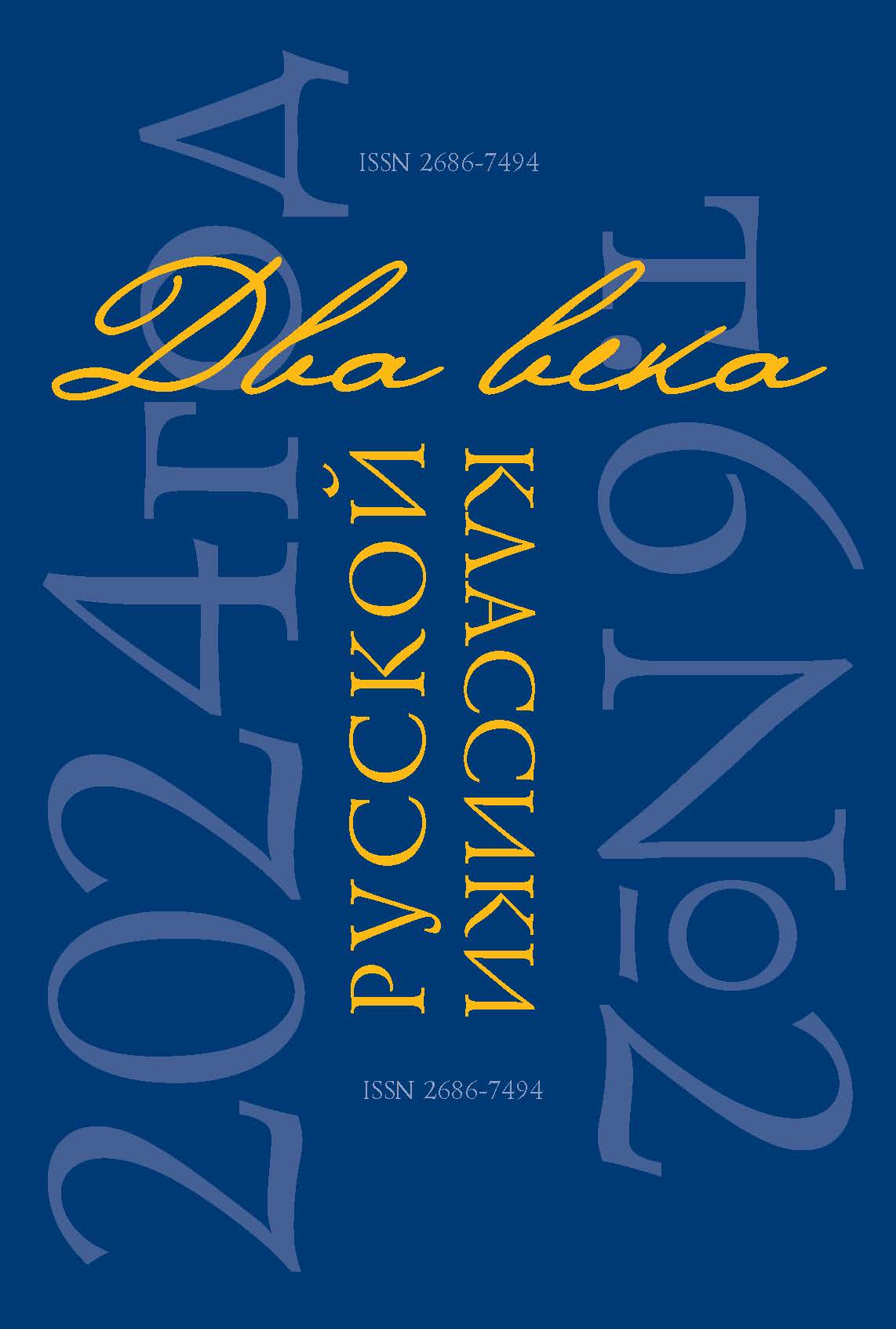Abstract:
The article presents the novel The Precipice as the final part of the novel trilogy by I. A. Goncharov (by analogy with the canticle “Paradise” in the composition of the “Divine Comedy” by A. Dante). So Raisky appears as the central (not declaratively, but essentially) character of the novel, crowning Goncharov’s ideas of a “serious human figure” and an “idealist character.” The article examines the image of Raisky in its evolutionary development, and designates the vector of his spiritual movement as an experience of falling, repentance and resurrection. The image of the ascetic artist Kirilov clearly manifests Goncharov’s ideas about the purpose of art, about the indecomposable unity of art and religion. It turns out that the spiritual evolution of Raisky — from the “Petersburg” part of the novel to the “Malinovskaya” and to the finale — takes place under the sign of Kirilov’s ideological and aesthetic attitudes, despite the fact that they do not coincide with installations of both Raisky and Goncharov himself. For the first time, the article shows the character of the plot, which is particular for the general meaning of the novel, connected with the spiritual duel of Vera and Mark Volokhov, since all the main meanings of the work, including biographical ones, converge in the figure of Raisky.
References
Geiro, L. S. “ʽSoobrazno vremeni i obstoiatel’stvam...’: (Tvorcheskaia istoriia romana ʽObryv’)” [“ʽAccording to Time and Circumstances...’: (Creative History of the Novel ʽPrecipice’)”]. I. A. Goncharov. Novye materialy i issledovaniia [I. A. Goncharov. New Materials and Research]. Moscow, IWL RAS, Nasledie Publ., 2000, pp. 83–183. (In Russ.)
Ivanova, S. M. “Rai kak tvorcheskoe sostoianie dushi cheloveka” [“Paradise as a Creative State of the Human Soul”]. Obraz raia: ot mifa k utopii [Image of Paradise: From Myth to Utopia]. St. Petersburg, Sankt-Peterburgskoe filosofskoe obshchestvo Publ., 2003, pp. 132–137. (In Russ.)
Kazakova, S. K. “Tri Vertera nad obryvom. Getevskie alliuzii v romane Goncharova” [“Three Werthers Over the Precipice. Goethe Allusions in Goncharov’s Novel”]. Voprosy literatury, no. 3, 2022, pp. 15–44. https://doi.org/10.31425/0042-8795-2022-3-16-44 (In Russ.)
Kozhinov, V. V. Proiskhozhdenie romana. Teoretiko-istoricheskii ocherk [The Origin of the Novel. Theoretical and Historical Essay]. Moscow, Sovetskii pisatel’ Publ., 1963. 440 p. (In Russ.)
Loskutnikova, M. B. “Ironiia kak pafos i stileobrazuiushchii faktor v romane I. A. Goncharova ʽObryv’.” [“Irony as Pathos and Style-forming Factor in I. A. Goncharov’s Novel ‘Cliff ’.”]. Vestnik Tsentra mezhdunarodnogo obrazovaniia MGU. Seriia Filologiia. Kul’turologiia. Pedagogika. Metodika, no. 3, 2011, pp. 103–108. (In Russ.)
Martsinkevich, N. E. Kul’turnye universalii v tvorchestve A. A. Bloka: semantika, funktsii, sposoby realizatsii [Cultural Universals in the Work of A. A. Blok: Semantics, Functions, Methods of Implementation: PhD Thesis, Summary]. Moscow, 2014. 34 p. (In Russ.)
Mel’nik, V. I. “I. A. Goncharov i Dante: voprosy poetiki” [“I. A. Goncharov and Dante: Questions of Poetics”]. Dva veka russkoi klassiki, vol. 3, no. 4, 2021, pp. 58–79. https://doi.org/10.22455/2686-7494-2021-3-4-58-79 (In Russ.)
Mel’nik, V. I. “Dantovskii epos v russkoi literature: Gogol’, Goncharov, Dostoevskii” [“Dante’s Epic in Russian Literature: Gogol, Goncharov, Dostoevsky”]. Dva veka russkoi klassiki, vol. 4, no. 1, 2022, pp. 68–117. https://doi.org/10.22455/2686-7494-2022-4-1-68-117 (In Russ.)
Mel’nik, V. I. “Evangel’skaia semantika zhenskikh obrazov Marfy i Very v romane I. A. Goncharova ʽObryv’.” [“Evangelical Semantics of Female Images of Martha and Vera in I. A. Goncharov’s Novel ʽThe Precipice’.”]. Problemy istoricheskoi poetiki, vol. 17, no. 1, 2019, pp. 78–93. https://doi.org/10.15393/j9.art.2019.5881 (In Russ.)
Mel’nik, V. I. “Tema donzhuanizma v tvorchestve I. A. Goncharova” [“The Theme of Don Juanism in the Works of I. A. Goncharov”]. Metod, zhanr, poetika v zarubezhnoi literature [Method, Genre, Poetics in Foreign Literature]. Frunze, Kyrgyz State University Publ., 1990, pp. 49–59. (In Russ.)
Mel’nik, V. I. “Etika kak estetika v tvorchestve I. A. Goncharova (ot krasoty plasticheskoi k krasote Khrista)” [“Ethics as Aesthetics in the Work of I. A. Goncharov (From Plastic Beauty to the Beauty of Christ)”]. Russkaia literatura v pravoslavnom kontekste [Russian Literature in an Orthodox Context], issue 2. Stavropol, Izdatel’skii tsentr StDS, Dizainstudiia B Publ., 2016, pp. 67–76. (In Russ.)
Mints, Z. G. “Simvol u A. Bloka” [“The Symbol of A. Blok”]. V mire A. Bloka [In A. Blok’s World]. Moscow, Sovetskii Pisatel’ Publ., 1981, pp. 172–208. (In Russ.)
Otradin, M. V. “Tvorcheskii spor, v kotorom geroi vsegda proigryvaet (Komicheskoe v romane I. A. Goncharova ʽObryv’)” [“Creative Debate in which the Hero Always Loses (Comic Element in I. A. Goncharov’s Novel ʽThe Precipice’)”]. Art Logos / Iskusstvo slova [Art Logos], no. 2, 2017, pp. 23–35. (In Russ.)
Piksanov, N. K. “Goncharov” [“Goncharov”]. Istoriia russkoi literatury [History of Russian Literature], vol. 8, part 2. Moscow, Leningrad, Academy of Sciences of the Soviet Union Publ., 1956, pp. 400–461. (In Russ.)
Plesner, Kh. Stupeni organicheskogo i chelovek: vvedenie v filosofskuiu antropologiiu [Stages of the Organic and Man: An Introduction to Philosophical Anthropology]. Moscow, Rossiiskaia politicheskaia entsiklopediia Publ., 2004. 368 p. (In Russ.)
Prutskov, N. I. Masterstvo Goncharova-romanista [The Mastery of Goncharov as a Novelist]. Moscow, Leningrad, Academy of Sciences of the Soviet Union Publ., 1962. 230 p. (In Russ.)
Rainov, T. I. “ʽObryv’ Goncharova kak khudozhestvennoe tseloe” [“ʽThe Precipice’ by Goncharov as an Artistic Whole”]. Voprosy teorii i psikhologii tvorchestva, vol. 7. Kharkiv, [S. n.], 1916. 286 p. (In Russ.)
Starygina, N. N. “ʽDusha v miatushchikhsia strastiakh’: (Obrazy Zhenshchin v Antinigilisticheskikh Romanakh Goncharova, Leskova, Dostoevskogo)” [“Images of Women in the Anti-nihilistic Novels of Goncharov, Leskov, Dostoevsky)”]. I. A. Goncharov: Materialy Mezhdunarodnoi konferentsii, posviashchennoi 185-letiiu so dnia rozhdeniia I. A. Goncharova [I. A. Goncharov: Materials of the International Conference dedicated to the 185th Anniversary of I. A. Goncharov’s Birth], comp. M. B. Zhdanova et al. Ulyanovsk, Oblastnaia tipografiia Pechatnyi dvor Publ., 1998, pp. 196–206. (In Russ.)
Tseitlin, A. G. “Goncharov” [“Goncharov”]. Literaturnaia entsiklopediia [Literary Encyclopedia], vol. 2. Moscow, Kommunisticheskaia akademiia Publ., 1929, col. 616–626. (In Russ.)









